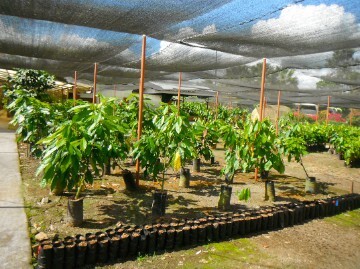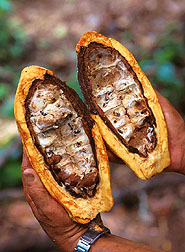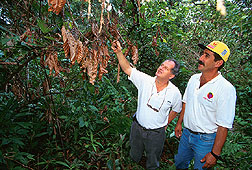Chocolate Production in Peril
 Cacao seedlings at the CATIE research station in Costa Rica. Doreen Pendgracs
Cacao seedlings at the CATIE research station in Costa Rica. Doreen Pendgracs "Most varieties produced worldwide belong to a narrow set of clones selected in the forties."
"Our goal is not just to produce cacao. It's also to give the basic living conditions to the farmers. Most cacao farmers are very poor, because the system is based on material that doesn't have good yielding capacity."
"I will be very happy when I leave this institution to know that the collection will be protected financially. It's a treasure for everybody, for all the cocoa lovers."
Wilbert Phillips-Mora, chief, genetic program, Tropical Agricultural Research and Higher Education Center, Costa Rica
 |
| Pathogenic fungi that cause witches' broom on cacao tree limbs and trunks also attack pods, destroying the valuable beans inside. (K8618-1) |
Few varieties of the cacao crop that produces the raw material for chocolate are commonly grown and cultivated, at a time when monoculture is being attacked worldwide for its narrow focus on growing crops with certain cultivated features that lend themselves to shelf life, shipping, and presumably quality of taste along with production yield. It became obvious to both growers and scientists that restricting crops to only certain types and narrowing diversity, when fungi or insect predators specific to those crops threaten, their devastation can prove difficult to cope with.
With a wider variety of seed types producing similar strains of crops, infestations that can devastate, common to a single type of crop form can wreak havoc in that single form, but the others will be free of threat, and the greater variety of crops of a single fruit type will survive. Yet farming and cultivation of fields on a wide, commercial scale have favoured single forms of crops rather than a diversity of them. From time to time threats arise against single crop forms that prove truly worrisome when science has no answer to the impending threat.
In Costa Rica trees have been planted in an wide variety of forms, all of which produce cacao, representing the International Cacao Collection, at a research institution, C.A.T.I.E. (Tropical Agricultural Research and Higher Education Center), in Turrialba. There, a wide assortment of forms produce a wide variety of cacao pods; some with protrusions, some spherical and green, some oblong with scaly skin, and their colours are varied from deep purple to bright yellow.

Martin Aitkin (left), director of the M&M Mars, Inc., Almirante Farm, and a local farmer assess damage from a large, dry witches'-broom growth in a cacao tree at the Luz de Maria farm in Uruçuca, Brazil. (K8636-1)
What they all have in common, despite the wide diversity of their appearance, is that the pods contain seeds yielding chocolate. Cacao is currently under threat as a result of diseases and environmental challenges made far more serious by the all-too-common cultivation of single-types of crop species. These varieties share similar or identical genetic traits and defects. And their similarity makes them vulnerable to variety-specific, swiftly-spreading blights.
A fungus -- Moniliophthora roreri (frosty pod rot) -- was noticed on cacao trees by Costa Rica farmers in the late 1970s, when pods began developing a white, fuzzy fungal coating which would eventually mummify the pods. By 1983, Costa Rica saw its exports of dry cacao beans decline by 96 percent, which shattered the industry, while the fungus continues its trajectory of infecting vulnerable single-type trees.
 |
| This photo shows cocoa pods at various stages of Frosty Pod Rot. Doreen Pendgracs |
The first batch of these hybrid cacao varieties was released in 2006, with the six hybrids producing roughly three times more cacao than the standard varieties. Following a trial of 11 years, one hybrid was identified with a 5 percent frosty pod rot infection rate, more than favourably comparing with the 75 percent infection rate for a control variety of cacao trees. The new pods are now in circulation being roasted and packaged.
That's the silver lining to the project Dr. Phillips-Mora is so proud of in his retirement years. There is a drawback, however, in that not all the hybrids he managed to create are capable of self pollinating; additionally, some of the beans they produce are small. They are not yet capable of resisting all the pathogens affecting cacao on a global scale. But a new batch of clones bred to solve some of these issues are near completing their field trials.
 |
| Credit: Photograph by Adam Voorhes |
Labels: Agriculture, Bioscience, Disease, Research

0 Comments:
Post a Comment
<< Home